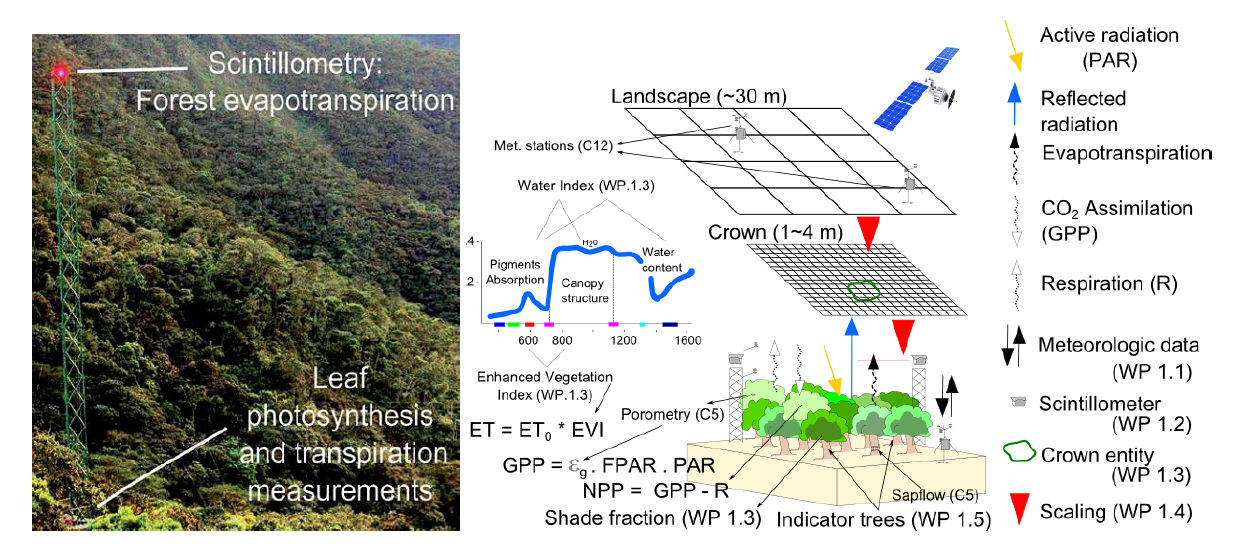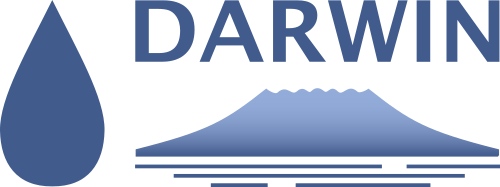DFG PAK 823-825: Development of area-wide functional indicators using remotely sensed data [funded by DFG] - Status: closed
Project staff:
Prof. Dr. Jörg Bendix
Abstract:
The main aim of this project is at the development and implementation of area-wide functional indicators (Evapotranspiration, Primary Production, and Water Use Efficiency) which can be used to monitor changes in tree water relations due to environmental change (land use and climate change) and to identify water sensitive indicator trees. Calibration and quality assessment of the algorithms are conducted, among others, with scintillometry above the tree canopy and porometry. At a regional perspective this project also aims at at the retrieval of area-wide structural and multi-/hyperspectral predictor variables from remote sensing data. Scientific findings will be used to implement an operational monitoring system together with the non-university cooperation partners in South Ecuador.
For more information please refer to the official project website:
http://www.tropicalmountainforest.org/content_subprojects.do?phase=3&subpage=aims&subprojectid=211
Description:
We investigate heat fluxes, evapotranspiration, and productivity at the canopy scale on the core plot in the valley of the San Francisco (South Ecuador).

Two observation towers (30 m height) are erected in the forest core plot in the research station for measurements of heat fluxes and evapotranspiration (ET) at the leaf and canopy level. Automatic scintillometer and weather sensors operate on the top of the towers and on ground for measuring heat fluxes and evapotranspiration at the canopy level. Porometry at leaf level is used for direct comparison with the canopy fluxes, including leaf photosynthesis. Individual tree crowns will be delineated to determine the indicators at crown level from high-resolution satellite data. Ancillary spectroscopy data has been carried out from the towers to obtain canopy spectral signatures and indices (e.g. water and vegetation indices), which will be used to calibrate/validate satellite data and to upscale the indicators from leaf to crown and landscape scales. Satellites (e.g. Worldview, Quickbird) have been deployed to acquire new high-resolution data throughout three years of monitoring. Field campaigns allow the characterization of the vegetation layer and the estimation of functional indicators at regional level.
Publications and poster presentations:
2018 - Carrillo-Rojas, G.; Silva, B.; Rollenbeck, R.; Celleri, R. & Bendix, J. (2018): The breathing of the Andean highlands: Net ecosystem exchange and evapotranspiration over the páramo of southern Ecuador. Agricultural and Forest Meteorology 265, 30-47.
- Gonzalez-Jaramillo, V.; Fries, A.; Zeilinger, J.; Homeier, J.; Paladines, J. & Bendix, J. (2018): Estimation of Above Ground Biomass in a Tropical Mountain Forest in Southern Ecuador Using Airborne LiDAR Data. Remote Sensing 10, 1.
2017 - Farwig, N.; Bendix, J. & Beck, E. (2017): Introduction to the Special Issue “Functional monitoring in megadiverse tropical ecosystems”. Ecological Indicators 83, 524–526.
- Strobl, S.; Cueva Ortiz, E.; Silva, B.; Knuesting, J.; Schorch, M.; Scheibe, R.; Bendix, J. & Beck, E. (2017): Water relations and photosynthetic water use efficiency as indicators of slow climate change effects on trees in a tropical mountain forest in South Ecuador. Ecological Indicators 83, 550–558.
- Tiede, Y.; Schlautmann, J.; Donoso, D.A.; Wallis, C.I.B.; Bendix, J.; Brandl, R. & Farwig, N. (2017): Ants as indicators of environmental change and ecosystem processes. Ecological Indicators 83, 527–537.
- Silva, B.; Alava Nunez, P.; Strobl, S.; Beck, E. & Bendix, J. (2017): Area-wide evapotranspiration monitoring at the crown level of a tropical mountain rain forest. Remote Sensing of Environment 194, 219–229.
2016 - Knoke, T.; Paul, C.; Hildebrandt, P.; Calvas, B.; Castro, L.M.; Härtl, F.; Döllerer, M.; Hamer, U.; Windhorst, D.; Wiersma, Y.F.; Curatola Fernández, G.F.; Obermeier, W.; Adams, J.; Breuer, L.; Mosandl, R.; Beck, E.; Weber, M.; Stimm, B.; Haber, W.; Fürst, C. & Bendix, J. (2016): Compositional diversity of rehabilitated tropical lands supports multiple ecosystem services and buffers uncertainties. Nature Communications 7, 11877.
- Silva, B.; Strobl, S.; Bendix, J. & Beck, E. (2016): Canopy evapotranspiration, leaf transpiration and water use efficiency of an Andean pasture in SE-Ecuador – a case study. Erdkunde 70(1), 5-8.
- Carrillo-Rojas, G.; Silva, B.; Cordova, M.; Celleri, R. & Bendix, J. (2016): Dynamic Mapping of Evapotranspiration Using an Energy Balance-Based Model over an Andean Páramo Catchment of Southern Ecuador. Remote Sensing 8(2), 160 (1-24).
- Tiede, Y.; Homeier, J.; Cumbicus, N.; Peña, J.; Albrecht, J.; Ziegenhagen, B.; Bendix, J.; Brandl, R. & Farwig, N. (2016): Phylogenetic niche conservatism does not explain elevational patterns of species richness, phylodiversity and family age of tree assemblages in Andean rainforest.. Erdkunde 70(1), 83-106.
- Kübler, D.; Günter, S.; Hildebrandt, P.; Stimm, B.; Weber, M.; Mosandl, R.; Muñoz, J.; Aguirre, N.; Cabrera, O.; Zeilinger, J. & Silva, B. (2016): Assessing the importance of topographic variables for the spatial distribution of tree species in a tropical mountain forest.. Erdkunde 70(1), 19-47.
- Bendix, J. & Beck, E. (2016): Environmental change and its impacts in a biodiversity hotspot of the south Eucadorian Andes - monitoring and mitigation strategies . Erdkunde 70(1), 1-4.
2015 - Cordova, M.; Carrillo-Rojas, G.; Crespo, P.; Wilcox, B. & Celleri, R. (2015): Evaluation of the Penman-Monteith (FAO 56 PM) Method for Calculating Reference Evapotranspiration Using Limited Data: Application to the Wet Páramo of Southern Ecuador. Mountain Research and Development 35(3), 230-239.
2011 - Silva, B. & Bendix, J., Modelling canopy Photosynthesis for two Grassland competing species. (ESA, Frascati, 2011).




